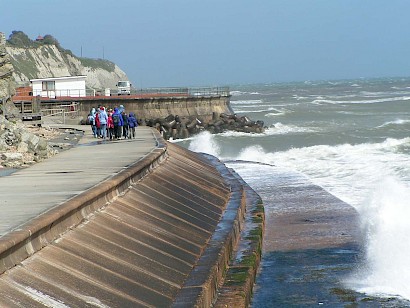Sea levels are rising at a staggering rate. We’re running out of time to act
 Over the past century, sea levels in the United States rose by approximately a foot. That is a staggering amount — and one that could be matched in just the next three decades, according to a new report from the National Oceanic and Atmospheric Administration, NASA and five other agencies. By 2050, U.S. sea levels could rise between 10 and 12 inches. In the East and the Gulf Coast, the figure could be even higher.
Over the past century, sea levels in the United States rose by approximately a foot. That is a staggering amount — and one that could be matched in just the next three decades, according to a new report from the National Oceanic and Atmospheric Administration, NASA and five other agencies. By 2050, U.S. sea levels could rise between 10 and 12 inches. In the East and the Gulf Coast, the figure could be even higher.
The impacts would be devastating. Coastal flooding has already become more frequent and harmful in areas such as Maryland’s Eastern Shore. By the middle of the century, “moderate” flooding events — ones that involve some damage to roads or structures and potentially require flood warnings and evacuations — could become 10 times more common than they are today.
The report, which also maps flooding projections across the country, provides a blueprint for local, state and federal authorities trying to adapt. It’s clear that deep structural changes must be made to the nation’s infrastructure, particularly in coastal areas — and soon.
Nearly 40 percent of the U.S. population lives in counties on the coast. If NOAA’s projection materializes by 2050, the Union of Concerned Scientists estimates 140,000 homes would be at risk of flooding on average once every two weeks. Ports and other commercial infrastructure along the coasts could also see serious damage, affecting supply chains and raising costs even for those living inland. Then there are the harms to coastal ecosystems, which are already reeling from erosion, flooding and lost habitats.
The report comes with an urgent warning: Emissions matter, both now and in the future. Thanks to heating that has already taken place, the 2050 projections will likely still materialize even if emissions are curbed. But if emissions are not reduced, the situation will be far worse: Sea level along the U.S. coastline could rise up to 7 feet by the end of the century, a catastrophic outcome.
White House climate adviser Gina McCarthy called the findings a sign that “our climate crisis … is blinking ‘code red.’ ” It’s yet another reminder of the importance of keeping temperature increases under 1.5 degrees Celsius by 2100, the threshold scientists warn we shouldn’t pass. That imperative won’t be achievable without large-scale policy changes to boost energy efficiency, clean technologies and alternatives to fossil fuels.
NOAA Administrator Rick Spinrad, for his part, described the report as a “wake-up call with a silver lining” because it offers practical information on how U.S. communities can prepare for changing climate realities. But the more we delay serious emissions cuts and the transition to a more sustainable society, the slimmer any potential silver lining will be. The threats to ecosystems, communities and livelihoods are growing. There is still time to act — but the window of opportunity is narrowing by the day.
You can return to the main Market News page, or press the Back button on your browser.

